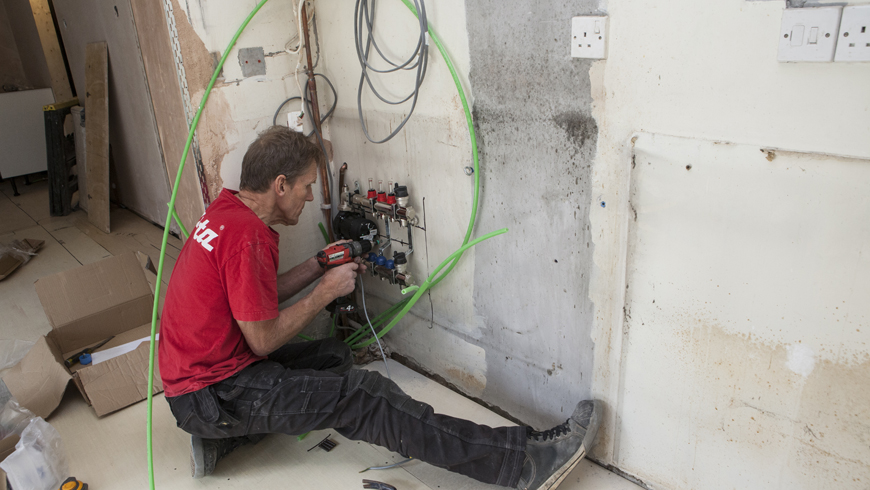
Roger Bisby gives Timoleon’s Toron UFH system the once over.
To my mind, installing underfloor heating in a suspended ground floor has always been slightly problematic. If you use the pipe in plate system under the boards, the heat has to travel through the floorboards and then through the floor covering. You also have to get a lot of insulation under the plates because heat will always travel to cold and there is no colder place in a house than a ventilated floor void. Why would it go up when it can go down?
Underfloor heating company Timoleon makes a system called Toron, which addresses these problems and is the best solution for suspended floors that I have seen. The 22mm thick floorboards are routed out on a CNC machine to accommodate the 12mm pex pipe on the top side rather than underneath. If you are thinking that you might just get your router out and achieve the same thing, forget it. The groove has an undercut so the pipe is retained.
The transition from one board to the next is done by lining up the cross channels. You also have to terminate the boards over a joist or put in a couple of noggins or an ‘H’ frame to support the ends. This is good practice with any chipboard flooring, but it is surprising how many people don’t always bother. The other thing that is often ignored is gluing of the tongue and groove. If you don’t do this the floor can squeak, which is very annoying and impossible to fix. I also like to use a bead of No Squeak adhesive on the joists to take up any small gaps.
Once the pipe has been laid, a layer of self adhesive foil heat dispersion tape is stuck over each pipe. This is detectable with a pipe detector, so it should help prevent screws being driven through the pipe. The next job is to glue and screw 6mm plywood over the top of the chipboard to encapsulate the pipes and restore the full structural strength of the floor. This is laid counter to the boards.
The job of fixing down the sheets was left to me, and I must admit I asked the boys not to talk to me while I was doing it. The key is to mark out the pipework clearly on the plywood face. There is plenty of room between the pipes, but the bit that really needs care is where the pipes are looped around. If you mark out the returns with a felt tip first you won’t go wrong.
The 12mm circuits are changed to 16mm to take them to and from the manifold. This requires a compression joint to be made. I have no doubt whatsoever that the compression joints are good – they have double internal seals – but I was always told to avoid any below floor joints in underfloor heating, and I managed to achieve this by placing the joints under the bottoms of the skirtings and under the kickspace of the kitchen units. The circuit directly adjacent to the manifold was joined in 12mm. The fittings allow this to be done if required.
The customers had chosen engineered oak for the kitchen flooring, which was a simple click system, so it should move as a single entity. I have had trouble with glued joints coming apart over underfloor heating but I found the customer had turned the blending valve up to 70°. Given that this is way too hot for any underfloor heating, I wonder why manufacturers make a valve that allows it. I always emphasise that the valve must never be turned up past the halfway mark, which is around 50°. If the floor isn’t warm enough, it is because somebody has skimped on the insulation or the loops are too far apart. The best way to run underfloor heating is on a low setting because this makes best use of a condensing boiler or renewables, but heating a pipe in screed takes time, and there will inevitably be times when the sun is shining through the bi-folds and the room cooks a little. The rapid response time of the Toron system, and the much lower thermal mass, means that over-heating is a lot less likely and, if there is an unexpected chilly morning, the floor will warm up within minutes of switching on. It is such an impressive system that you could even lay the boards on insulation over concrete as a floating floor and forget about the pipe in screed.












